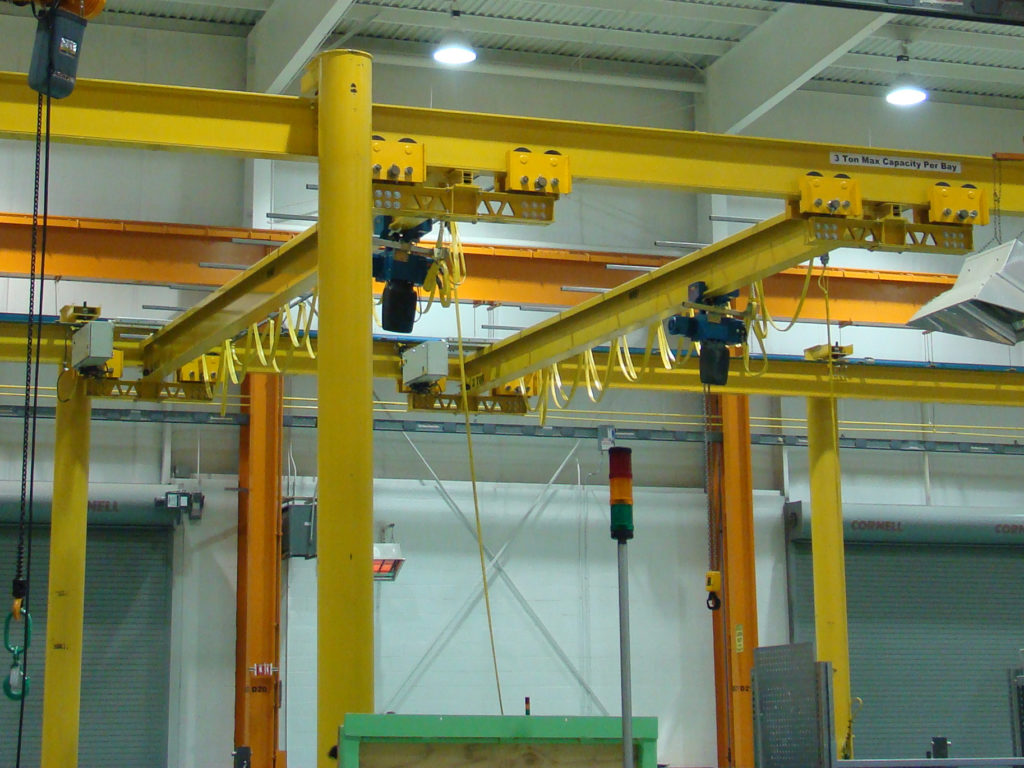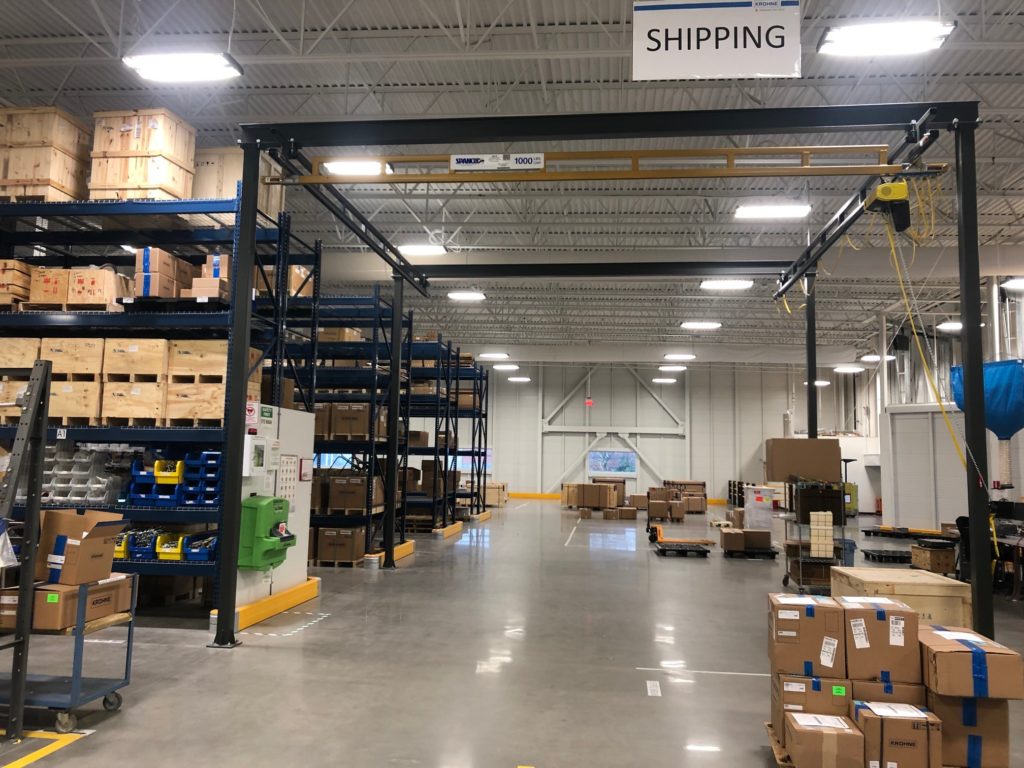
Enclosed Track Workstation Bridge Cranes Vs. I-Beam Overhead Traveling Cranes
Mar 14, 2019
When most people think of cranes, they think of overhead traveling cranes with an I-beam type girder. While these cranes are certainly common and the right crane for certain applications, for capacities of two tons or less, many crane buyers overlook a better and even less expensive option: enclosed track workstation bridge cranes.
Spanco’s Enclosed Track Workstation Bridge Cranes have a rolling resistance that is far less than I-beam cranes. For example, the force needed to move the trolley is equal to about 0.8 percent of the total suspended load. In other words, a 500-pound load would require just four pounds of force! The secret to the ease of movement is the enclosed track design and low rolling resistance polyamide wheels with high-quality bearings. Moving an I-beam crane of any capacity by hand is almost impossible. Because of the ease of movement, most enclosed track workstation bridge cranes don’t require motorization of the trolleys or even the bridge unless it is at the two-ton capacity or long spans, such as 23 feet or longer. If motorization is required due to the capacity, span, or simply customer preference, motorization packages do significantly increase the cost of the system. Nevertheless, the entire system installed is usually much cheaper than I-beam cranes, which almost always require motorization due to the weight and rolling resistance of the trolley on the lower flange of the I-beam and the end truck wheels on ASCE rail along the runway or on the bottom flange of the runway beam for under-running models.
Because of their modular design, enclosed track workstation bridge cranes are easier, quicker, and cheaper to install (and move later if the factory configuration changes) than traditional I-beam cranes. Spanco Freestanding Workstation Bridge Cranes require no special foundation beyond the standard six-inch thick reinforced concrete floors found in most factories. Furthermore, Spanco Freestanding Workstation Bridge Cranes in most cases do not require any tie off to the building columns or any special bracing or support. Spanco Ceiling-Mounted Workstation Bridge Cranes are also available, which will eliminate the support columns and free up valuable floor space compared to a freestanding workstation bridge crane or an I-beam crane with its own support structure.
Unlike almost all I-beam cranes, Spanco standard Freestanding Workstation Bridge Cranes shown in our price guides are approved per IBC seismic requirements for all locations of the lower 48 U.S. states, including California and Oregon (up to 14-foot trolley-clevis height, maximum 30-foot support centers, and up to 34-foot bridge lengths). For systems exceeding these specifications, Spanco recommends the purchase of a PE package to determine seismic requirements. One important intrinsic technical advantage of the enclosed track design is that the trolley is trapped inside the track and cannot accidently come out even in case of seismic activity or the unlikely failure of the trolley wheels. I-beam cranes use trolleys that wrap around the lower flange of the beam and end trucks that ride on the rail, each of which are susceptible to falling during a seismic event.
Now let’s talk about price—price is actually one of the best advantages of enclosed track workstation bridge cranes compared to I-beam cranes. The total installed price of a typical one-ton workstation bridge crane, for example, is usually a fraction of the cost of a similar capacity and size I-beam crane, and the lower the capacity, the greater the price advantage for enclosed track workstation bridge cranes. It is hard not to justify the investment in a workstation bridge crane when the average installed price is around $20,000 – $25,000. Plus, the maintenance costs are much less over the lifetime of the system as well.
Beyond the functionality and lower costs of purchase and ownership, the workstation bridge cranes are more ergonomic and take up less space in your facility. Spanco Workstation Bridge Cranes are rated for class C moderate service. Most I-beam cranes are rated either class C or D, but you should check with the manufacturer to verify the duty class and determine the class needed based on your particular application and service requirements. Spanco Workstation Bridge Cranes are available in capacities ranging from 250 to 4,000 pounds. If you need to lift more than two tons, a crane buyer has many options to choose from including traditional I-beam or box girder overhead traveling cranes, gantry cranes, or even jib cranes. Each crane type is designed for specific functionality and has its own pros and cons. To be sure you are choosing the right crane for your application, we recommend consulting an experienced crane manufacturer who is a member of CMAA and or MMA to ensure that you buy a safer crane built to the Spec 70 or Spec 74 industry norms.
Spanco is a member of CMAA and MMA, and all of our cranes are proudly made in the U.S.A. and carry a 10-year limited warranty for all mechanical components (see our warranty for more details). By way of comparison, most I-beam cranes come with a one-year warranty from the manufacturer.
If you do not need full coverage of a work area, enclosed track Spanco Monorail Cranes may be another option, and even less expensive than the workstation bridge cranes. To get a better idea of which crane is best for you, please visit our product pages to see our full line of cranes along with pictures, videos, case studies, and many technical details. Contact us so we can help guide you to the right material handling system for your specific requirements.
About the Author
Jeff Brazwell is the VP of Sales at Spanco and has over 20 years of experience in the crane industry, selling both enclosed track and I-beam and box girder overhead traveling cranes. Jeff graduated from the University of West Florida with a B.S. in Business/Marketing and is active in MHI (Material Handling Institute) and a few of its industry trade groups, CMAA and MMA.
Categories
Share this post
Contact us
Looking for the perfect fall protection equipment? Let us help!

